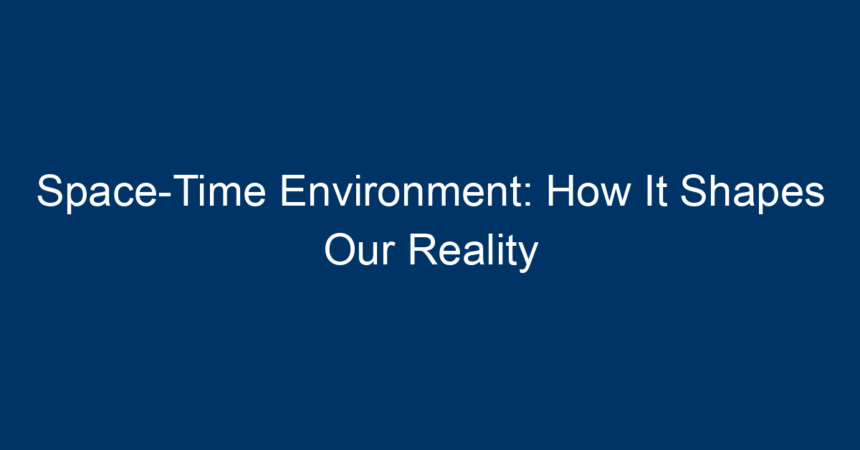Introduction
The concept of space-time environment emerges as a crucial framework through which we grasp the universe’s complexities. It intertwines the dimensions of space and time into a single continuum, influencing everything from the orbits of celestial bodies to the very fabric of our daily lives. Understanding this intricate relationship not only enhances our grasp of physics but also offers profound insights into how our reality is shaped.
In this article, we will explore the fundamental aspects of the space-time environment, its implications in various fields, and how it can influence our perception of reality. Join us as we delve into this captivating subject.
What is Space-Time?
The Basis of Space-Time
Space-time combines the three dimensions of space (length, width, height) with the fourth dimension, time. This concept, rooted in Einstein’s theory of relativity, suggests that rather than existing in isolation, space and time are interconnected. Objects within this continuum move through both space and time, resulting in a dynamic interplay that shapes the conditions of our reality.
The Geometry of Space-Time
At its core, the space-time environment is a geometric structure where the positions of objects and events are plotted within this four-dimensional framework. This geometry can be curved by mass and energy, leading to phenomena such as gravity. For instance, massive celestial bodies like planets warp the space-time around them, influencing the trajectory of nearby objects.
The Impact of Space-Time on Our Reality
Gravity: The Warping of Space-Time
One of the most significant implications of the space-time environment is gravity. According to Einstein, mass causes a curvature in space-time, resulting in what we perceive as gravitational pull. This understanding revolutionized our grasp of motion and forces in the universe. For example, it delves into why planets orbit stars in predictable paths and how satellites remain in stable orbits around Earth.
Time Dilation: Perception of Time
Time, as part of the space-time environment, can behave in peculiar ways. An intriguing aspect of this is time dilation, which states that time moves slower in stronger gravitational fields or for objects moving at high speeds. This phenomenon has been confirmed by experiments involving atomic clocks in fast-moving jets versus stationary ones. The implications of time dilation not only stretch the boundaries of physics but also invite philosophical reflections on the nature of time and reality.
Light and Space-Time: The Cosmic Messenger
Light, traveling at a constant speed in a vacuum, also plays a pivotal role in the space-time environment. Its interactions with massive objects illustrate how space and time are linked. For instance, the bending of light around stars, known as gravitational lensing, serves as evidence for the curvature of space-time. This phenomenon allows astronomers to observe distant galaxies, providing insight into the universe’s expansive nature.
Applications of Space-Time in Technology
GPS Technology: Harnessing Space-Time
One of the most practical applications of the space-time environment is found in Global Positioning System (GPS) technology. GPS satellites operate in high orbits, where both time dilation due to their speed and their position relative to Earth’s gravitational field affect their timekeeping. To ensure accuracy, GPS systems must account for these time discrepancies, illustrating the real-world ramifications of our understanding of space-time.
Quantum Computing: The Space-Time Connection
As we venture into emerging fields like quantum computing, the space-time environment continues to influence technological advances. Quantum systems operate under principles that challenge classical intuitions about time and space. Understanding these relationships could lead to the development of new computational methods that leverage the unique properties of space-time.
Cultural and Philosophical Perspectives on Space-Time
Space-Time in Philosophy
The concept of the space-time environment raises philosophical questions about our existence and perception of reality. Philosophers have long debated the nature of time—whether it is absolute or relative. How we understand space and time shapes our worldview and influences fields like ethics and metaphysics.
Art and Literature: Exploring Space-Time
The intersection of art and the space-time environment can also be observed in literature and visual arts. Writers and artists have long used the concept of time travel and distorted realities to explore human experiences. Works like H.G. Wells’ "The Time Machine" and films such as "Interstellar" engage with these themes, prompting audiences to ponder their own realities within the space-time continuum.
Conclusion
The space-time environment is far more than an abstract scientific concept; it serves as the fabric of our reality. By understanding the interplay between space and time, we can better appreciate the fundamental forces that shape our world. From the orbits of planets to the intricate technology we use daily, the implications of this framework are profound.
Actionable Insights
-
Educate Yourself: Explore more about Einstein’s theory of relativity and its implications in physics. Books and documentaries can provide more profound insights.
-
Stay Updated: Follow scientific advancements that stem from our understanding of space-time, particularly in technology and quantum physics.
-
Engage with Philosophy: Reflect on the philosophical implications of space-time and how it influences your worldview. Consider how our perception of time affects our daily lives.
- Experiment with Thought: Engage with literature and art that tackles the complexities of space and time. This can stimulate creative thinking and broaden your understanding.
Understanding the space-time environment enriches our appreciation of reality itself, paving the way for endless exploration and discovery. The more we learn, the more the universe reveals its intricate wonders—each moment a testament to the grandeur of the cosmos.




